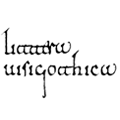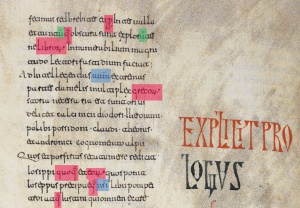Medieval abbreviations (II). Medieval period
How did medieval scribes used the Late Roman abbreviations? Did they understand them in the same way?
In the last post, I wrote about the origin of the medieval abbreviation system explaining briefly the techniques used by the Romans –classified as abbreviations by singula litterae, suspension and contraction, Tironian notes, notae iuris, and nomina sacra – for shortening words. In this post, I will focus my attention on summarising how these methods were adapted throughout the medieval period, giving some tips on how to study them effectively.
From the Late Roman to the Middle Ages
With the beginning of the Middle Ages, for each one of the national writing systems that preceded the expansion of Caroline minuscule –Visigothic and also Merovingian, Beneventan and Insular scripts –, the traditional Roman methods to shorten words started to be interpreted in a different manner corresponding to the evolution of writing techniques and different cultural contexts.
Although the basis was preserved, the active use of abbreviations made some fall into oblivion (ex. most of the Tironian notes; the notae iuris were preserved although not recognising their origin and being just used as abbreviations by suspension or contraction), while others were not only in vogue but also served as foundation for the development of almost all the medieval system (nomina sacra). Therefore, departing from the same methods, a new whole system for shortening words began to be used to the point that not only each writing system but even some specific production centres or scriptoria employed their own distinctive set of abbreviations [on the image above, an example; in green lack of nasals, in red by special signs, and in blue by contraction and/or suspension – Add. 11695, f.221v © The British Library].
Visigothic script abbreviations
Visigothic script has their own system of abbreviating words, one for the cursive variant, another for the minuscule variant, and another one too for the transitional typological variants of the script combining Visigothic and Caroline abbreviations. Studying the ones handled by the scribes for each variant, their construction and evolution, entails practice and can be a bit chaotic bearing in mind the amount of constructions used –especially from the 11th century on –, but also such uniqueness as for the myriad of options at their disposal provides very useful information to date and place manuscript sources as well as to deepen the cultural context of scribes and written testimonies.
The methodology I always use for analysing Visigothic script abbreviations entails 4 major points that gather all possible techniques for shortening words during the period (8th-14th centuries). It is based on the different types or systems for condensing words used in medieval writing systems – essentially classified into two groups, by suspension and by contraction –, but modified aiming to study the application of each method (how the scribe drawn and used the abbreviation) and its evolution instead of the type of technique itself.
Following this model it is easy to obtain a graphic profile of each hand’s abbreviation system, what allows then to make comparisons, find out the more probable school or centre for the scribe, the manuscripts he more likely read (since several abbreviations can be found only in some specific genres), the external cultural influence he was surrounded for, and also his or her chronological period. Once having a corpus of a couple of hundreds, just by analysing the abbreviations, sources can be placed in context with a small margin of error.
(1) General sign
![]()
FIG. 1 Example of macron
First, I always check the design employed to draw the general sign of abbreviation, also called macron [FIG. 1]. This sign comes from the Roman period and was spread in parchment thanks to its widespread use in the nomina sacra, as we have seen, and is the most basic element that needs to be analysed. Although it was first just a more or less horizontal line above the letters left behind for condensing the word, it can also present numerous styles since it evolves with the writing system itself; a different type of stroke equals to a different type of macron.
(2) Lack of nasals

FIG. 2 Example of macron used to indicate lack of nasal
Besides its general use for noting that there is a shortened word in the text, which can correspond to any type of the common set of abbreviations of each writing system (see below), the macron was used during the Middle Ages to mark a very simple an specific abbreviation: the lack of nasals, m and n [FIG. 2].
These nasals can be absent from the middle of the word (for example in omnia abbreviated as oia) or, more likely, at the end (as in the example formam). The general sign was exactly the same for both uses, and for both nasals, for long – in the last centuries of Visigothic script a point was added over the line –, which means that it does not necessarily present a graphic difference, so one needs to recognise when the abbreviation is only eliding a nasal or indicates an entirely different word.
(3) Special signs

FIG. 3 Abbreviations by special signs: cuius, genus, qui, que, nobis
The third point entails the analysis of the abbreviations that tend to change the most between typological variants of Visigothic script: abbreviations by special signs [FIG. 3]. This type is formed basically by some letters of the reduced word followed by a sign which, depending on its shape, indicates a specific set of letters usually from the last part of the word (ex. us, um, is). The design of the special signs employed tends to show first exogenous influence (from Caroline minuscule).

FIG. 4 General abbreviations by contraction and suspension: frater, quod, uel, episcopus, sancti, propter, nostris
(4) General abbreviations
Finally, the last group gathers all the abbreviations made with some letters plus the general sign [FIG. 4] and those Tironian notes and notae iuris that were remnant during the medieval period for the regular ecclesiastical texts and legal charters. Therefore, within the first group, nomina sacra, abbreviations by suspension (including singula littera) and abbreviations by contraction, that changed over time.
All Visigothic script scribes had this very complete method for signifying abbreviations, and all these options were used from the 8th to the 14th century, although not with the same intensity. In general, in the earliest examples, their use was frequent but not profuse, especially in ecclesiastical texts, while from the 12th century on some scribes abbreviated almost every single word in a sentence.
In the next post I will go through these four points of analysis summarising the designs of the general sign, the macron, the special signs and some of the general abbreviations (contraction and suspension, Tironian notes and notae iuris) found in Visigothic script manuscripts (cursive, minuscule, and transitional variants) and their evolution.
by A. Castro
[edited 12/07/2018]

